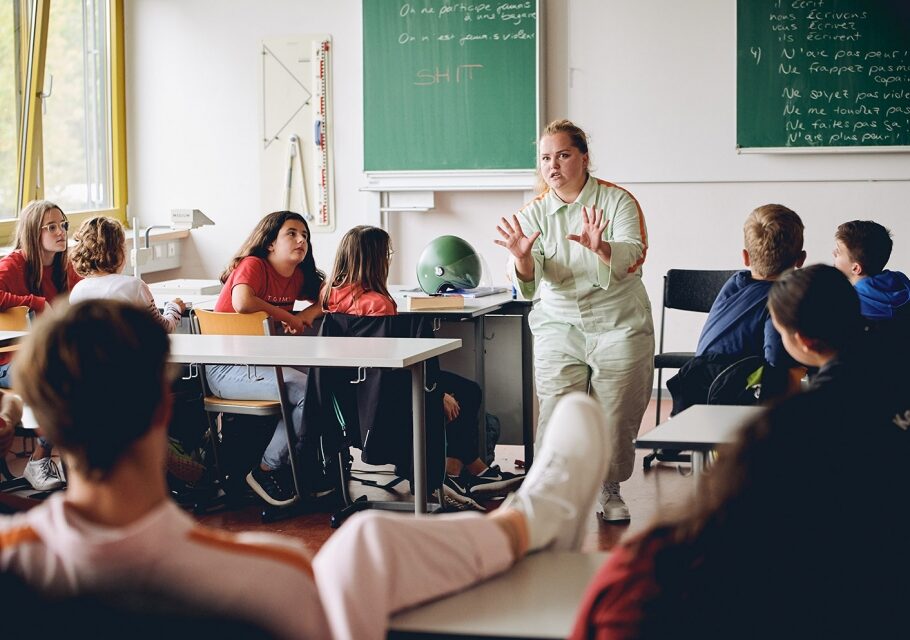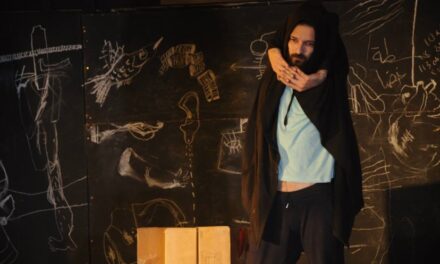In his 1993 work A Flying Classroom, the German author Erich Kästner created a vision of a classroom that defies the limits of the possible, and rises to fantastic heights. While this vision is in the form of a play within the plot of his popular children’s book, it nonetheless provides a space for direct confrontations and collectively experienced adventures. While we can assume that the author did not intend to propose a new concept for integrating theatre into everyday school life when his work underlines the importance of personal experience and cultural encounter, the idea of mobile theater productions for schools still holds a trace of his utopian vision.
Even though the phenomenon of the classroom play may not be new, especially in the German-speaking world, more and more theaters, large and small, are leaving their sacred halls and heading to auditoriums, gymnasiums, and classrooms. While a stage-like situation can still be created in an auditorium or gymnasium, theatre in a classroom is the most limited kind of mobile production. Preparing the Karlsruhe contribution to Young Europe III, once again demonstrated how different the demands on a play are, depending on whether its realization is intended for the stage or the classroom. Due to different spatial settings for the individual productions of the three partner theaters, it was initially difficult to develop material as a collaboration once concrete ideas for implementation came into play. It should be noted that what works in the classroom remains feasible on stage, while the opposite is obviously much more difficult.
Performing in a classroom does not seem very enticing at first glance: it entails a maximum performance time of sixty minutes, early morning travel, logistical restrictions with regard to props, scene changes, and ensemble size; and almost no support in the form of stage design, lighting or other typical production means in the theatre. These constraints raise questions that are never relevant for a stage production: how much can the situation convey; that is, how much of the world can fit into a classroom? And further, how can this world be manifested with a small selection of props, and nevertheless be rendered as realistic and plausible as possible? A text conceived for this purpose can choose either to make major claims or deploy the fewest words possible to create vivid imagery spoken by the actors. In this format, conveying a place, time, and situation is the sole responsibility of the actors; generally, there are no dramaturgical aids, such as stage sets to set the scene, or light changes to create atmosphere. In addition, neither the ramp nor the Fourth Wall keeps the audience in check. Instead, the actors have to create entire worlds solely through their own performances, and they have to accomplish this in a variety of spaces. Under these circumstances, the physical co-presence of the actors and their audience plays an especially important role. When they go to the theater, school-aged children leave the structure of their everyday lives behind and are required to submit to a set of rules that apply to a larger theatre audience. In the case of a classroom play, however, the situation is almost reversed: here, the actors enter into the morning routine of the exclusive audience-forming class community, where they are subjected to the unwritten rules of their everyday dynamics. While every theatrical space, even the most intimate studio stage, is inscribed within the clear framework of the as-if and the particularities of a foreign site, which serves to create distance, the play performed between the blackboard and the seats has to address the audience in their familiar everyday world. Whether the audience consists of adolescents or primary school children, they usually play according to their own rules in their “own” four walls, posing questions and making demands more clearly than they would have on a visit to the theater.
“The exclusivity of the performance for this closed group of people creates a special bond between the characters and their audience.”
So why bother? Why do we accept all of these constraints and perform theatre in classrooms? Do we do it just to save the teachers the trouble of traveling to the theater? Well, yes. Especially in rural areas, the costs and logistics required to travel to the theater can present insurmountable obstacles, so this is an important step in bringing theatre to every child. However, there is more to it: the exclusivity of the performance for this closed group of people creates a special bond between the characters of their audience. Unlike in a classic theatre situation, the dividing line does not run between the actors on stage and the audience in front of it, but rather between the transformed world of the classroom and the outside world. Furthermore, not only do pupils experience their classroom in a completely different way, but the teachers do as well. Being put in an observatory position, they become part of the audience, too. The constellation of relationships in the classroom shifts, and group dynamics change. Another aspect of a classroom play that cannot be recreated in any other theatre setting in quite the same way is the common wrap-up phase, most commonly consisting of the opportunity to ask the actors questions and talk about the play or a series of theatre-pedagogical exercises in a group that is already familiar with each other.
Theatre in a classroom cannot and does not want to be either a substitute or a competing even to a performance in a “real” theater. Nevertheless, every aspect that has been mentioned as a challenge for production teams in creating theatre pieces for the classroom at the same time is an opportunity to experience theatre in its most basic, rawest form. It does offer a unique set of experiences that open up the world of theater to pupils with such immediacy that it can make a lasting impression on them, demonstrating how a simple play can transform the reality of a room. Here we come back to Erich Kästner’s vision, in which the everyday life of a classroom community becomes a shared adventure that forges connections between a person’s own everyday world, and the big wide world outside. In so doing, it creates both the desire and courage to experience more of it.
This article was originally published by the European Theatre Convention as part of Youth Theater: A Casebook and has been reposted with permission. To read the original article, click here.
This post was written by the author in their personal capacity.The opinions expressed in this article are the author’s own and do not reflect the view of The Theatre Times, their staff or collaborators.
This post was written by Lena Fritschle.
The views expressed here belong to the author and do not necessarily reflect our views and opinions.


















